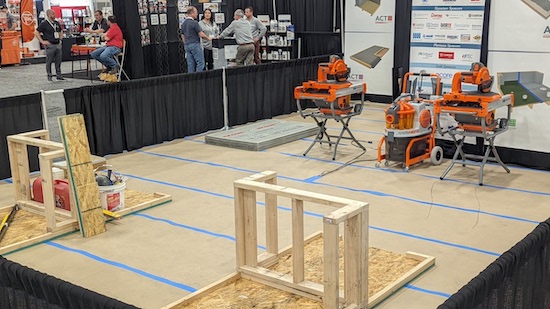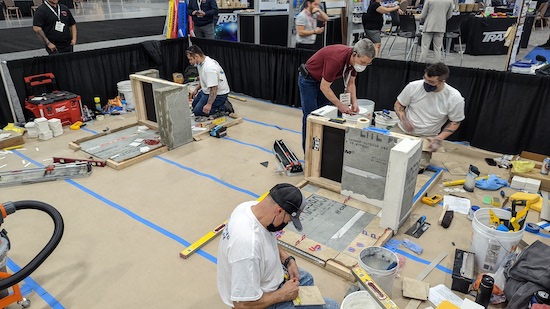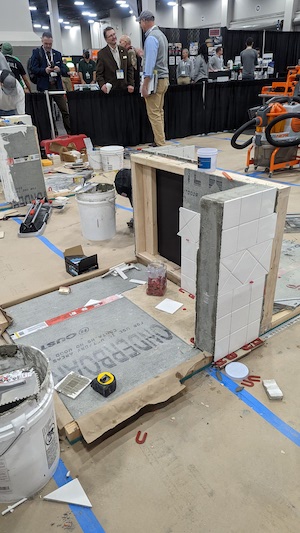Beginning in April, we started offering candid, informal, quarterly updates with Brad Denny, the new CTEF Executive Director, in this “CTEF Journal.” Denny shares both about his personal journey as new CTEF Executive Director and how he is looking to lead the Foundation into the future. – Editor
Whoa! First, I didn’t understand how many moving parts there are to put on a certification test and second, I am learning very quickly just how fragmented our installation world is regarding skillsets!
It is exciting to have so many people passionate about putting themselves out there and willing to have their work examined – in depth – by a third party. I mean, we all think we are great installers, but when we have our work picked apart using ANSI A108 and the TCNA Handbook as litmus tests, are we as great as we think we are?
So many around the country are taking the opportunity to do just that. Guess what? It’s harder than it looks and many of us don’t know what we don’t know.

- Maybe we are accustomed to using spacers for everything and aren’t practiced using modular math.
- Maybe we thought this trowel was great for coverage, but it really isn’t.
- Do we really understand the methods and standards the way we think we do, especially regarding EJ171?
- Maybe we thought that templating was a great idea for every project, but it isn’t right for this one; or maybe we should have templated because we are fast at that.
- Do we need to wean ourselves from the wet saw and use a snap cutter more, or minimize our steps back and forth to the saw?
- Do we need to think more about how we spend our time during the day and how many breaks it requires to get through a project? Are there some better work habits we can institute?
- Does our arrangement of our jobsite and cleanliness help us be more efficient, or are we slowing ourselves down because we keep things too tidy?
- Do we set goals for ourselves and segment our day to focus on the task and get it done before we move to the next thing, or do we get overwhelmed with the big picture?
- Did we prepare enough by reading or watching any informational videos about our task?
- Should we have spent some time practicing [insert task here] that we don’t normally do but are being asked to do and be graded on?
- Did we consider that the wall or floor would be better to run first? Could we do the border first, and then stack the wall tile on it – or maybe we should just shim up the wall and leave room to slide the floor under it? If we lay all the floor first, will we spend the rest of the time in an uncomfortable position leaning over the wet floor tile? Which is better to have a little wet when grouting – the wall or the floor? Can we get a proper movement accommodation joint if we don’t run the floor first? So much to consider!!!!!
When I look back on my own test, I can hardly remember that day. It was stressful! I would seriously have to get a real game plan together if I had to do it again, and I would use every resource available to me to prepare for it. At the time, I don’t think Scott Carothers had created the training videos that are available on the website. I would certainly invest the time to study those.
While I was taking my test, I had no idea how much work had been done by others to get ready for it. I now know that trade shows are the absolute hardest!


Typical CTI tests around the country follow these steps:
- CTEF seeks areas where we could get a minimum of five installers to test.
- CTEF searches for a host and once identified, finds an Evaluator willing to conduct the test.
- Evaluator is identified and contacted to get on the schedule. This Evaluator is now responsible for several steps.
- Contact the host to confirm the date and location.
- Reach out to installers to establish a rapport and ensure they are working to get the written part of the test finished.
- If possible, visit the site in advance and discuss the specifics with the host.
- Each side of the module needs 10′ x 10′ plus an area for the materials.
- Saws need an area with adequate electricity and space nearby.
- Determine floor protection.
- Identify debris disposal and water supply and disposal.
- Arrange for the materials to be donated for the test. If not provided by the host, they must locate them, schedule the pick-up, and be prepared to deliver them to the test site.
- Two weeks before the test, ensure installers have finished the written test and are ready for orientation.
- The day of orientation, arrive at the site and begin setting up for the test. Make sure the floor is protected, construct the modules, arrange the materials, and set up the video presentation.
- At orientation, allow installers to bring in tools, sign the photo release and waiver, watch the orientation and time management videos, discuss the instructions, and understand the critical points. Questions can be asked at this time, and then the floor protection paper can be installed inside the modules.
- On test day, arrive early, have everything ready to go, reinforce last-minute instructions, conduct the test, and record scores.
- During the test, for each installer, the Evaluator is responsible for accurately scoring 83 different attributes. Evaluators also make sure all flows correctly, resolve any disputes, and make sure the materials/electricity/water are as they should be.
- After the test – as soon as possible – go back over each score sheet and ensure everything is correct before submitting all the paperwork back to CTEF. Many times those who didn’t pass are consulted.
- CTEF receives the paperwork, rechecks all math, tallies scores, contacts everyone, then mails out certificates and cards.
- CTEF then enters CTIs into the locator on the website.


It’s an incredible amount of work that requires four entities come together – CTEF, Host, Evaluator, and Student who have their own schedules and agendas. When it does come together and the installer is prepared, it is a beautiful thing! I need to look closely at all of this and work hard to do anything I can to make it better!
Got questions or comments? Contact Brad at [email protected].


Brad Denny
Brad Denny CTI #1190 has been intensely active in the tile industry for many years. He has served as Region 6 Director for the National Tile Contractors Association (NTCA), received the NTCA Dedication to Membership award – a recognition specially created just to honor his passion for methods, standards, and the internet – and chaired the NTCA’s Social Media Subcommittee as well as moderated the Tile Geeks Facebook group.
Brad also served as the Co-Chairman of the NTCA Training and Education Committee with Sam Bruce of Visalia Tile for 2020 and 2021.
In 2021, Brad received the prestigious NTCA Tile Person of the Year Award. This award is given to someone who has positively impacted NTCA through participation in the Association's programs.
Before becoming Executive Director for CTEF, Brad was vice president and COO of Nichols Tile & Terrazzo Co, Inc., a family-owned tile contractor business located outside of Nashville, Tenn., and NTCA Five-Star Contractor Member of the NTCA.







